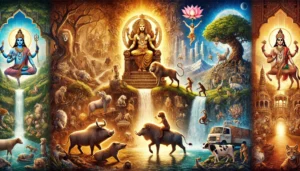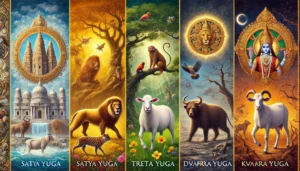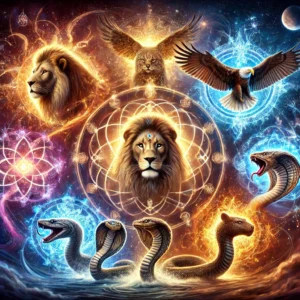
Divine role of animals in Hindu mythology
Animal Yugas: Significance of Sacred Animals in Each Era
The concept of the four Yugas—Satya, Treta, Dwapara, and Kali—represents the cyclical progression of time and morality in Sanatan Dharma. Each Yuga is marked by a distinct decline in dharma (righteousness), with animals playing crucial roles as divine manifestations, moral exemplars, or spiritual symbols. Animals in Hindu philosophy are not seen as mere creatures but as embodiments of cosmic truths, often bridging the gap between humans and divinity. This article explores the significance of sacred animals across the Yugas, their roles in mythological narratives, and the lessons they impart to humanity.
Satya Yuga: The Age of Truth and Purity
The first and most righteous Yuga, Satya Yuga, is characterized by truth, virtue, and harmony between all beings. Animals in this era are portrayed as divine forms, reflecting their sacredness in maintaining cosmic balance.
Narasimha (The Lion Avatar):
One of Lord Vishnu’s ten avatars, Narasimha (half-lion, half-man) signifies the triumph of dharma over adharma (injustice). When Hiranyakashipu, an asura (demon), defied the gods and sought immortality, Vishnu manifested as Narasimha to protect his devotee Prahlada. The lion’s form represents courage, power, and divine justice, showcasing the importance of animals as conduits of cosmic intervention.
Kamadhenu (The Celestial Cow):
Kamadhenu, the wish-fulfilling cow, is a symbol of abundance and prosperity. She emerges during the churning of the cosmic ocean (Samudra Manthan) and is revered in the Vedic tradition for her ability to nourish humanity. Kamadhenu exemplifies the qualities of selflessness and sustenance, reinforcing the sacred bond between humans and animals.
Hamsa (The Divine Swan):
The swan is associated with Lord Brahma and Saraswati, symbolizing wisdom and discernment. It is said to have the ability to separate milk from water, reflecting spiritual discrimination (viveka) and purity.
Table of Contents

Divine role of animals in Hindu mythology
Treta Yuga: The Age of Sacrifice and Valor
As dharma declines in Treta Yuga, divine beings and animals unite to combat rising evils. Animals become messengers of moral ideals, teaching virtues like loyalty, devotion, and sacrifice.
Jatayu (The Valiant Eagle):
In the epic Ramayana, Jatayu is a noble eagle who attempts to rescue Sita from Ravana. Despite his age, Jatayu fights valiantly, sacrificing his life in the process. His actions underline themes of loyalty, courage, and the willingness to stand for dharma even in the face of adversity.
Hanuman (The Monkey God):
Hanuman, an incarnation of Lord Shiva, is a central figure in Treta Yuga. His role as a devoted servant of Lord Rama highlights the values of humility, strength, and unwavering faith. Hanuman’s animal form underscores the spiritual potential of beings often dismissed as inferior, reminding us that divinity transcends physical appearance.
Rama’s Allies (Vanaras and Jambavan):
The Vanara (monkey) army and Jambavan, the bear king, play critical roles in aiding Lord Rama during his quest to rescue Sita. Their collective efforts emphasize unity, courage, and the harmony between humans and animals in achieving higher goals.
Sita’s Connection with Deer:
The golden deer, a key element in the Ramayana, symbolizes illusion (maya). Sita’s desire for the deer leads to her abduction, demonstrating how attachment to worldly desires can result in suffering.
Dwapara Yuga: The Age of Doubt and Conflict
Dwapara Yuga is marked by greater moral decline and increased human conflict. Divine interventions involving animals continue to guide humanity, emphasizing dharma amidst rising chaos.
Krishna and the Cows:
As a cowherd, Lord Krishna’s childhood is deeply connected to cows, underscoring their sanctity in Vedic culture. Krishna’s act of lifting Govardhana Hill to protect his devotees highlights the interdependence of humans, animals, and nature. The cow, symbolizing motherhood and nourishment, becomes a spiritual cornerstone in this era.
Garuda (The Divine Eagle):
Garuda, the mighty eagle and Vishnu’s vehicle, represents speed, strength, and protection. In the Mahabharata, Garuda’s stories emphasize vigilance, freedom, and loyalty to the divine cause.
Naga Legends:
Serpents play significant roles in Dwapara Yuga. Vasuki, the serpent king, aids in the churning of the ocean, while Ananta Shesha, the thousand-headed serpent, symbolizes infinity and supports Lord Vishnu as he rests. Nagas also appear as protectors of treasures and spiritual wisdom.
Krishna and Kaliya:
In the Bhagavata Purana, Krishna’s subjugation of Kaliya, a venomous serpent poisoning the Yamuna River, symbolizes the restoration of ecological balance. This tale reflects the need to harmonize human actions with nature.

Divine role of animals in Hindu mythology
Kali Yuga: The Age of Darkness and Strife
The present age, Kali Yuga, is characterized by moral degradation and spiritual decline. However, animals remain integral to rituals and mythology, serving as reminders of dharma.
The One-Legged Cow:
In Kali Yuga, the cow is depicted as standing on one leg, symbolizing the fragile state of dharma. Protecting cows becomes synonymous with preserving virtue and righteousness.
Dogs in the Mahabharata:
In the epic’s final chapter, a dog accompanies the Pandavas on their journey to heaven. The dog’s loyalty to Yudhishthira signifies faithfulness, dharma, and the enduring connection between animals and humanity.
Sacred Animals in Temples:
Bulls, elephants, and peacocks retain their sacred status in temple rituals and festivals. For instance, elephants are used in processions, symbolizing majesty and strength, while peacocks are associated with Lord Kartikeya and divine beauty.
Ecological and Spiritual Roles:
Despite the moral decline in Kali Yuga, animals continue to remind humanity of its spiritual duties. They serve as symbols of nature’s resilience and our responsibility to coexist with all life forms.
Timeless Lessons from Animal Yugas
Across the four Yugas, animals have been pivotal in shaping spiritual narratives and reinforcing ethical principles. They teach us:
Unity in Diversity: Each creature, regardless of its form, has a unique role in the cosmic order.
Compassion and Coexistence: Respecting and protecting animals is essential for spiritual and ecological harmony.
Spiritual Allegory: Animals symbolize virtues and vices, offering lessons for personal and societal growth.
In an era like Kali Yuga, revisiting these ancient tales is more relevant than ever. The stories of Narasimha, Jatayu, Garuda, and others inspire humanity to uphold dharma, protect nature, and recognize the divine spark in all living beings. As custodians of the planet, we are reminded of our duty to nurture and coexist with animals, ensuring that their sacred legacy endures for future generations.

Divine role of animals in Hindu mythology
FAQs on Animal Yugas: Unveiling the Divine Role of Sacred Animals in Each Era
General Questions
- What does the term “Animal Yugas” mean in Hindu mythology?
The term “Animal Yugas” refers to the symbolic and divine roles that specific animals played in each yuga (Satya, Treta, Dvapara, and Kali) according to Hindu mythology. These animals were often associated with deities, avatars, and cosmic principles, reflecting the themes and values of their respective eras.
- How are animals perceived in the context of Sanatan Dharma?
Animals are seen as sacred beings in Sanatan Dharma, often embodying divine virtues. Many animals are venerated as the vehicles (vahanas) of gods, divine messengers, or manifestations of cosmic energies, emphasizing the interconnectedness of life.
- Why are animals prominent in Hindu mythological stories?
Animals in Hindu mythology often symbolize qualities like courage, devotion, wisdom, and loyalty. Their presence in mythological stories teaches moral lessons, reinforces dharma, and reflects humanity’s bond with nature.
Sacred Animals in Each Yuga
- What role did animals play in the Satya Yuga?
In Satya Yuga, the age of truth and righteousness, animals symbolized the purest virtues. Examples include:
Narasimha (Lion Avatar): Represents divine justice and strength in Vishnu’s fight against the demon Hiranyakashipu.
Nandi (Bull): The vehicle of Lord Shiva, symbolizing dharma, patience, and strength.
Kamadhenu (Divine Cow): A celestial being representing abundance and nourishment.
- How were animals significant in the Treta Yuga?
Treta Yuga featured animals as allies and protectors of dharma:
Hanuman and the Vanaras (Monkey Warriors): Played crucial roles in assisting Lord Rama in the Ramayana, representing devotion, courage, and teamwork.
Jatayu (Vulture): Sacrificed himself trying to save Sita, symbolizing loyalty and selflessness.
Deer in Sita’s Story: The golden deer is a symbol of illusion (maya), leading to significant events in the Ramayana.
- What divine roles did animals play in the Dvapara Yuga?
In the Dvapara Yuga, animals were seen as companions and symbols of divine love:
Cows: Associated with Lord Krishna, symbolizing abundance, love, and nurturing. Krishna’s childhood as a cowherd (Gopal) underscores the cow’s spiritual significance.
Garuda (Eagle): As Vishnu’s mount, Garuda embodies speed, strength, and protection.
Serpents (Shesha and Kaliya): Shesha is Vishnu’s cosmic serpent, representing infinity and stability, while Krishna’s subjugation of Kaliya reflects the triumph of good over evil.
- What is the role of sacred animals in Kali Yuga?
In Kali Yuga, sacred animals embody hope and resilience amidst the age of decline:
Cows: Represent the last leg of dharma, standing for purity, sustenance, and compassion.
Dogs: In some traditions, dogs are revered as loyal protectors, even associated with Bhairava (a form of Shiva).
Peacocks: Symbolize beauty, spirituality, and divine grace, often associated with Lord Kartikeya.
Mythological Connections and Lessons
- What is the connection between Narasimha and Satya Yuga?
Narasimha, Vishnu’s lion-headed avatar, appeared in Satya Yuga to protect Prahlada and restore dharma by defeating Hiranyakashipu. This story symbolizes the divine intervention to uphold truth and righteousness.
- Why is Jatayu revered in the Ramayana?
Jatayu, the noble vulture, fought valiantly against Ravana to save Sita. His sacrifice represents courage, loyalty, and selflessness in the face of evil.
- What is the symbolism of Krishna’s relationship with cows?
Krishna’s bond with cows in the Dvapara Yuga reflects his role as a nurturer and protector. The cow symbolizes the Earth and sustenance, highlighting the importance of respecting nature.
- How do sacred animals convey dharma in different yugas?
In each yuga, sacred animals exemplify qualities necessary to sustain dharma, such as strength (lion), patience (bull), devotion (monkey), and resilience (cow). They serve as reminders of divine virtues.
- What lessons do mythological animals teach us about modern life?
The stories of sacred animals remind us of values like loyalty, courage, and respect for nature. They encourage harmonious coexistence and ecological awareness.
Environmental and Spiritual Insights
- What environmental lessons can we draw from Animal Yugas?
Animal Yugas teach that animals are sacred cohabitants of the Earth. Protecting them and maintaining ecological balance aligns with dharma. Reverence for animals fosters sustainability.
- How does the concept of sacred animals inspire modern conservation efforts?
The reverence for animals in Hindu mythology can inspire initiatives for wildlife protection and environmental conservation by emphasizing their spiritual and ecological importance.
- Are there any rituals or festivals dedicated to sacred animals?
Yes, several rituals and festivals honor sacred animals. For example:
Govardhan Puja: Honors cows and bulls during Diwali.
Nag Panchami: Celebrates serpents and their spiritual significance.
Garuda Panchami: Worships Garuda as Vishnu’s divine mount.
- How does Kali Yuga emphasize the role of sacred animals in sustaining dharma?
In Kali Yuga, the cow represents dharma’s last surviving leg, emphasizing the need to protect and nurture life to uphold balance in a chaotic era.
Temples and Worship of Sacred Animals
- Are there temples dedicated to sacred animals?
Yes, many temples are dedicated to sacred animals, such as:
Nandi Temples: Dedicated to Shiva’s bull, Nandi.
Garuda Temples: Worshiping Vishnu’s vehicle, Garuda.
Snake Temples: For the worship of Nagas, such as the Mannarasala temple in Kerala.
- What is the significance of Kamadhenu in temple rituals?
Kamadhenu, the celestial cow, is invoked in rituals as the source of prosperity and blessings, symbolizing divine nourishment and abundance.
- Are there any stories of animals achieving liberation (moksha)?
Yes, animals like Jatayu and Gajendra (the elephant king) are believed to have attained moksha through their devotion and actions, demonstrating that even animals are part of the spiritual journey.
Philosophical and Modern Perspectives
- How do sacred animals bridge mythology and spirituality?
Sacred animals serve as spiritual symbols in mythology, connecting divine principles with earthly life. Their stories carry timeless messages for moral and ethical living.
- What is the modern relevance of sacred animals in Hindu mythology?
Sacred animals remind us to honor and protect nature in a world increasingly disconnected from it. They inspire reverence for life and promote ecological balance.
- Can the idea of Animal Yugas inspire contemporary storytelling?
Absolutely. The concept of Animal Yugas can inspire stories, movies, and literature that blend mythology with themes of environmentalism, spirituality, and ethics.
Summary
Animal Yugas – Unveiling the Divine Role of Sacred Animals in Each Era
The concept of Animal Yugas highlights the symbolic and divine roles of animals across the four yugas—Satya, Treta, Dvapara, and Kali—as narrated in Hindu mythology. Sacred animals are revered as embodiments of divine qualities, vehicles (vahanas) of deities, or participants in cosmic events, representing the interconnectedness of all life forms and the balance of dharma.
In Satya Yuga, animals like the lion (Narasimha avatar of Vishnu), the bull (Nandi), and the cow (Kamadhenu) symbolize strength, truth, and abundance in a world governed by righteousness.
Treta Yuga features animals such as Hanuman and the vanaras (monkeys) as loyal allies, Jatayu (vulture) as a symbol of sacrifice, and the deer as a metaphor for illusion (maya). These animals play crucial roles in Lord Rama’s journey to uphold dharma.
In Dvapara Yuga, Lord Krishna’s relationship with cows exemplifies nurturing and love, while Garuda (eagle) and serpents (Shesha and Kaliya) embody strength, protection, and cosmic stability.
In Kali Yuga, the cow stands as the last representation of dharma, symbolizing purity and compassion amidst moral decline. Other animals like dogs (associated with Bhairava) and peacocks signify loyalty and spirituality.
The stories of these sacred animals convey profound lessons on virtues like loyalty, courage, devotion, and resilience. They remind humanity of the need to coexist with nature harmoniously and respect all life forms. The reverence for animals in Hindu mythology inspires ecological consciousness and sustainable living.
Ultimately, the concept of Animal Yugas teaches us that animals are not merely physical beings but spiritual entities contributing to the cosmic order and upholding dharma across the ages.
Related Articles
- The Tridevi: Lakshmi, Saraswati, and Parvati – Their Roles and Powers
- “Divine Creatures of Ancient Indian Scriptures: Exploring the Role of Animals in the Vedas, Puranas, and Mahabharata”
- Nature and Spirituality: Exploring the Sacred Essence of the Himalayas, Ganga, and Other Natural Wonders”
- “Reviving the Gurukul System: Relevance and Lessons for Modern Education”
- “Exploring Greek and Indian Mythology: Similarities Between Greek and Indian Mythology “
- “Embracing Sattvic Living: Harmonizing Mind, Body, and Soul Through Food and Lifestyle”
- “Charity and Prosperity: Exploring the Concept of Daan and Its Financial Relevance in Modern Life”
- How to Build an Eco-Friendly Home Inspired by Vastu Shastra
- Comparison of Ancient and Modern Sports: How Traditional Sports Have Influenced Contemporary Games
- “Timeless Lessons from Ancient Tales: Linking Samudra Manthan and Ganga’s Descent to Modern Ecological Challenges”
- “Reviving Sanskrit: How AI is Preserving Ancient Languages for the Future”
- “Mathura: The Sacred Land of Lord Krishna’s Divine Leelas”
- Investing for Future Generations: Lessons from Indian Traditions on Legacy Building and Wealth Preservation
- “Ancient Indian Wisdom: Timeless Lessons for Tackling Today’s Climate Crisis”
- “Artificial Intelligence and Spirituality: Transforming Ancient Practices for the Modern World”
- “Gold and Real Estate in India: Timeless Assets Shaping Financial Strategies”
- “Divine Feminine Power in Hindu Mythology: The Legends of Durga, Saraswati, and Lakshmi”
- “Divine Beings of Sanatan Dharma: The Spiritual Significance of Sacred Animals in Hinduism”
- “Symbolism in Mythological Art: Unlocking Hidden Meanings in Ancient Temple Carvings”
- “Exploring Technological Advancements in Ancient India and Civilizations: Vimana, Metallurgy, & Water Management systems”
- Unveiling the Mysteries: Ancient Temples of Sanatan Dharma , Mysterious Temples of India
- “The Scientific Knowledge of Sanatan Dharma: Ancient Wisdom Meets Modern Science”
- Ancient Indian Sports and Games: Celebrating a Legacy of Skill, Strength & Strategy”
- “Exploring the Cosmic Link: The Connection Between Astronomy and Vedic Astrology”
- The Power of Sanskrit: Unlocking the Divine Language of the Gods
- “The End of Kaliyuga: A Sanatan Insight into the World’s Final Chapter”
- Explore more articles on Prachin Sanatan Yuga.
yugas yugas yugas yugas
